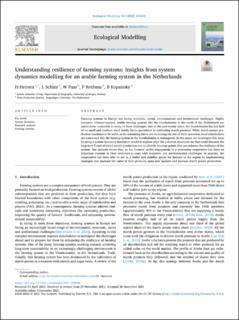| dc.contributor.author | Herrera, Hugo | |
| dc.contributor.author | Schütz, Lilli | |
| dc.contributor.author | Paas, Wim | |
| dc.contributor.author | Reidsma, Pytrik | |
| dc.contributor.author | Kopainsky, Birgit | |
| dc.date.accessioned | 2022-06-15T11:29:28Z | |
| dc.date.available | 2022-06-15T11:29:28Z | |
| dc.date.created | 2021-12-06T09:58:59Z | |
| dc.date.issued | 2022 | |
| dc.identifier.issn | 0304-3800 | |
| dc.identifier.uri | https://hdl.handle.net/11250/2998863 | |
| dc.description.abstract | Farming systems in Europe are facing economic, social, environmental and institutional challenges. Highly intensive, climate-exposed, arable farming systems like the Veenkoloniën in the north of the Netherlands are particularly vulnerable to many of these challenges. Just in the past twenty years, the Veenkoloniën has lost half of its small and medium sized family farms specialised in cultivating starch potatoes. While starch potato production continues to be stable as the remaining farms are increasing the size of their operation, local stakeholders are concerned that the farming system in the Veenkoloniën is endangered. In this paper we investigate this issue by using a system dynamics simulation model to explore what the potential structures are that could threaten the long term future of starch potato production and to identify leverage points that can enhance the resilience of the system. Our analysis shows that, so far, farmers’ active engagement in a processing cooperative has been an important element to their resilience to cope with economic and environmental challenges. In practice, the cooperative has been able to act as a buffer and stabilise prices for farmers in the region by implementing strategies that increase the value of their products, open new markets and increase starch potato production. | en_US |
| dc.language.iso | eng | en_US |
| dc.publisher | Elsevier | en_US |
| dc.rights | Navngivelse 4.0 Internasjonal | * |
| dc.rights.uri | http://creativecommons.org/licenses/by/4.0/deed.no | * |
| dc.title | Understanding resilience of farming systems: Insights from system dynamics modelling for an arable farming system in the Netherlands | en_US |
| dc.type | Journal article | en_US |
| dc.type | Peer reviewed | en_US |
| dc.description.version | publishedVersion | en_US |
| dc.rights.holder | Copyright 2021 The Authors | en_US |
| dc.source.articlenumber | 109848 | en_US |
| cristin.ispublished | true | |
| cristin.fulltext | original | |
| cristin.qualitycode | 1 | |
| dc.identifier.doi | 10.1016/j.ecolmodel.2021.109848 | |
| dc.identifier.cristin | 1964915 | |
| dc.source.journal | Ecological Modelling | en_US |
| dc.identifier.citation | Ecological Modelling. 2022, 464, 109848. | en_US |
| dc.source.volume | 464 | en_US |

